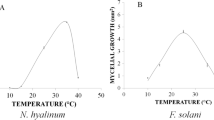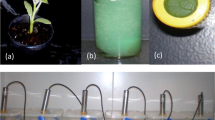Abstract
Biocontrol of the whitefly Trialeurodes vaporariorum (Westwood) (Hemiptera: Aleyrodidae) using entomopathogenic fungi has been a difficult challenge under greenhouse conditions. In order to select fungal isolates adapted to high temperature and extremely low moisture nine isolates of Lecanicillium lecanii (Zimmerman) Zare & W. Gams, L. attenuatum Zare & W. Gams and L. longisporum (Petch) Zare & W. Gams (Hypocreales: Clavicipitaceae) were evaluated. In vitro assays were performed to determine colony radial growth, conidial production and conidial germination in three water activity media (aw = 0.97, 0.98 and 1.00) at 28 and 32 °C. Virulence of Lecanicillium spp. isolates was evaluated against third instar T. vaporariorum on tomato plants at 23 °C. Colony radial growth, conidial production and germination decreased with the reduction in water activity, while 32 °C was extremely detrimental for all fungal isolates. However, some isolates were able to grow and produce conidia at low water activity and high temperature. Additionally, mortality above 60 % was recorded for one of these isolates. Practical implementation of biocontrol of T. vaporariorum under greenhouse production systems should consider the selection of those Lecanicillium isolates that show tolerance to the adverse environmental conditions in greenhouses.



Similar content being viewed by others
References
Abbott WS (1925) A method for computing the effectiveness of an insecticide. J Econ Entomol 18:265–267
Alvarez E, Sutton DA, Cano J, Fothergill AW, Stchigel A, Rinaldi MG, Guarro J (2009) Spectrum of zygomycete species identified in clinically significant specimens in the United States. J Clin Microbiol 47:1650–1656
Borneman J, Hartin RJ (2000) PCR primers that amplify fungal rRNA genes from environmental samples. Appl Environ Microbiol 66:4356–4360
Chandler D, Heale JB, Gillespie AT (1994) Effect of osmotic potential on the germination of conidia and colony growth of Verticillium lecanii. Mycol Res 98:384–388
Cortez-Madrigal H, Alatorre-Rosas R, Mora-Aliguera G, Bravo-Mojica H, Ortiz-García CF, Aceves-Navarro LA (2003) Characterization of multisporic and monosporic isolates of Lecanicillium (=Verticilium) lecanii for the management of Toxoptera auratii in cocoa. BioControl 48:321–334
Drummond J, Heale JB (1988) Genetics studies on the inheritance of pathogenicity in Verticillium lecanii against Trialeurodes vaporariorum. J Invertebr Pathol 52:57–65
Drummond JD, Heale JB, Gillespie AT (1987) Germination and effect of reduced humidity on expression of pathogenicity in Verticillium lecanii against glasshouse whitefly Trialeurodes vaporariorum. Ann Appl Biol 111:193–201
Ekbom BS (1981) Humidity requirements and storage of the entomopathogenic fungus (Verticillium lecanii) for use in greenhouses. Ann Entomologici Fennici 47:61–62
Faria M, Wraight S (2001) Biological control of Bemisia tabaci with fungi. Crop Prot 20:767–778
Gervais P, Molin P (1988) Influence of the water activity of a solid substrate on the growth rate and sporogenesis of filamentous fungi. Biotechnol Bioeng 31:457–463
Goettel MS, Koike M, Kim JJ, Aiuchi D, Shinya R, Brodeur J (2008) Potential of Lecanicillium spp. for management of insects, nematodes and plant diseases. J Invertebr Pathol 98:256–261
Griffin DM (1977) Water potential and wood-decay fungi. Ann Rev Phytopathol 15:319–329
Hall RA (1984) Epizootic potential for aphids of different isolates of fungus Verticillium lecanii. Entomophaga 29:311–321
Hocking AD, Pitt JI (1979) Water relations of some Penicillium species at 25 °C. Trans Br Mycol Soc 73:141–145
Inglis GD, Goettel MS, Butt TM, Strasser H (2001) Use of hyphomycetes fungi for managing insect pests. In: Butt TM, Jackson CW, Magan N (eds) Fungi as biocontrol agents. Progress, problems and potential. CAB International, Wallingford, UK, pp 23–69
Jackson CW, Heale JB, Hall RA (1985) Traits associated with virulence to the aphid Macrosiphoniella sanborni in eighteen isolates of Verticillium lecanii. Ann Appl Biol 106:39–48
Kim JJ (2007) Influence of Lecanicillium attenuatum on the development and reproduction of the cotton aphid, Aphis gossypii. BioControl 52:789–799
Köhl J, Postma J, Nicot P, Ruocco M, Blum B (2011) Stepwise screening of microorganisms for commercial use in biological control of plant-pathogenic fungi and bacteria. Biol Control 57:1–12
Kope HH, Alfaro RI, Lavallée R (2008) Effects of temperature and water activity on Lecanicillium spp. conidia germination and growth, and mycosis of Pissodes strobi. BioControl 53:489–500
Li G, Yuhua Y, Liying W (1991) Influence of temperature and nutrition on growth of the entomopathogenic fungus, Verticillium lecanii (Beijing strain). Chin J Biol Control 7:115–119
Lopez-Lorca LV, Carbonell T (1998) Use of almond mesocarp for production of entomopathogenic fungus Verticillium lecanii. Can J Microbiol 44:886–895
Magan N (2001) Physiological approaches to improving the ecological fitness of fungal biocontrol agents. In: Butt TM, Jackson C, Magan N (eds) Fungi as biocontrol agents: progress, problems and potential. CAB International, Wallingford, UK, pp 239–251
MGAP-DIEA/DIGEGRA (2012) Superficie con hortalizas y producción total según zona y modalidad productiva. http://www.mgap.gub.uy/portal/hgxpp001.aspx?7,5,27,O,S,0,MNU;E;2;16;10;6;MNU. Accessed 20 May 2013
Milner RJ, Luton GG (1986) Dependence of Verticillum lecanii (Fungi:hypomycetes) on high humidities for infection and sporulation using Myzus persicae (Homoptera:Aphidae) as host. Environ Entomol 15:380–382
Monteiro AC, Barbosa CC, do Correia AC, Pereira GT (2004) Crescimento e esporulação de isolados de Verticillium lecanii sobre diferentes fatores ambientais. Pesqui Agropecu Bras 39:561–565
Norrish RS (1966) An equation for the activity coefficient and relative humidities of water in confectionery syrup. J Food Technol 1:25–39
Osborne LS, Landa Z (1992) Biological control of whiteflies with entomopathogenic fungi. Fla Entomol 75:456–471
Quesada-Moraga E, Maranhao EAA, Valverde-García P, Santiago-Álvarez C (2006) Selection of Beauveria bassiana isolates for control of the whiteflies Bemisia tabaci and Trialeurodes vaporariorum on the basis of their virulence, thermal requirements and toxicogenic activity. Biol Control 36:274–287
Sugimoto M, Masanori K, Hideyuki N (2001) Ribotyping of entomopathogenic Verticillium lecanii in Japan. Phytoparasistica 29:1–8
Vidal C, Fargues J, Rougier M, Smits N (2003) Effect of air humidity on the infection potential of hyphomycetous fungi as mycoinsecticides for Trialeurodes vaporariorum. Biocontrol Sci Techn 13:183–198
Vu VH, Hong SI, Kim K (2007) Selection of entomopathogenic fungi for aphid control. J Biosci Bioeng 6:498–505
White TJ, Bruns T, Lee S, Taylor J (1990) Amplification and direct sequencing of fungal ribosomal RNA genes for phylogenetics. In: Innis MA, Gelfnad DH, Sninsky JJ, White TJ (eds) PCR protocols. A guide to methods and applications. Academic Press, New York, USA, pp 315–322
Willmer P (1986) Microclimatic effects on insects at the plant surface. In: Juniper B, Southwood R (eds) Insects and the plant surface. Edward Arnold, London, UK, pp 65–80
Wraight SP, Carruthers RI, Jaronsky ST, Bradley CA, Garza JC, Galaini-Wraight S (2000) Evaluation of the entomopathogenic fungi Beauveria bassiana and Paecilomyces fumosoroseus for microbial control of the silver leaf whitefly, Bemisia argentifolii. Biol Control 17:203–217
Yokomi RK, Gottwald TR (1988) Virulence of Verticillium lecanii isolates in aphids determined by bioassay. J Invertebr Pathol 51:250–258
Zare R, Gams W (2001) A revision of Verticillium section prostrata. IV. The genera Lecanicillium and Simplicillium gen nov. Nova Hedwigia 73:1–50
Acknowledgments
We are very grateful to Beatriz Dini and Alfredo Fernández from National Institute of Agricultural Research (INIA)—Las Brujas, for their participation in this work. We are also especially grateful with Dr. Gabriel Ciappesoni (INIA) for his excellent statistical assistance.
Author information
Authors and Affiliations
Corresponding author
Additional information
Handling Editor: Nicolai Meyling.
Rights and permissions
About this article
Cite this article
Rivas, F., Nuñez, P., Jackson, T. et al. Effect of temperature and water activity on mycelia radial growth, conidial production and germination of Lecanicillium spp. isolates and their virulence against Trialeurodes vaporariorum on tomato plants. BioControl 59, 99–109 (2014). https://doi.org/10.1007/s10526-013-9542-y
Received:
Accepted:
Published:
Issue Date:
DOI: https://doi.org/10.1007/s10526-013-9542-y




